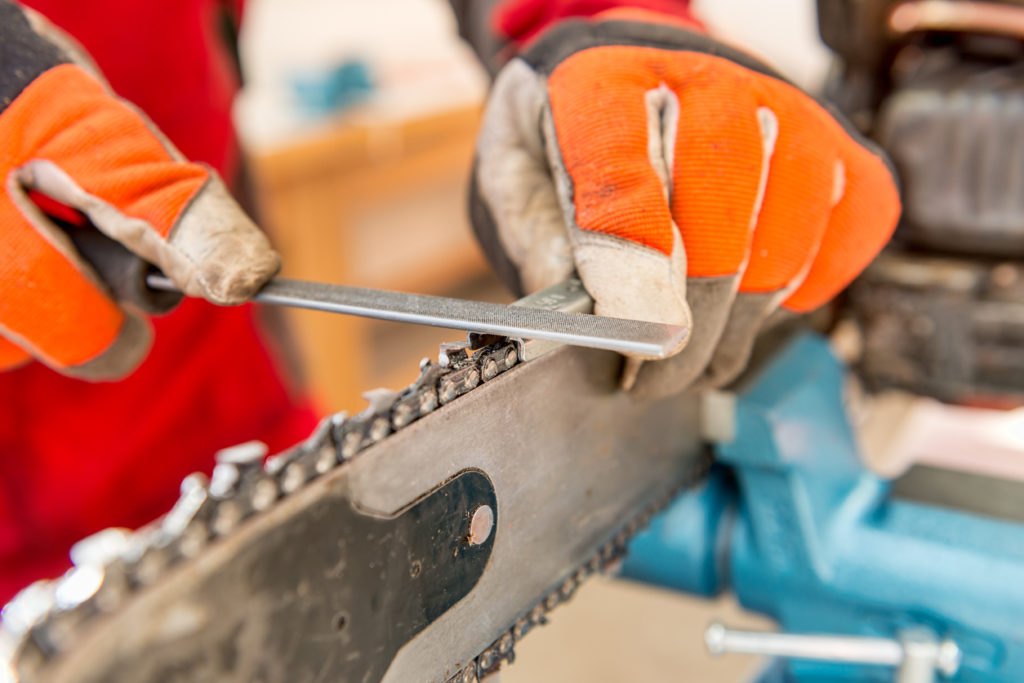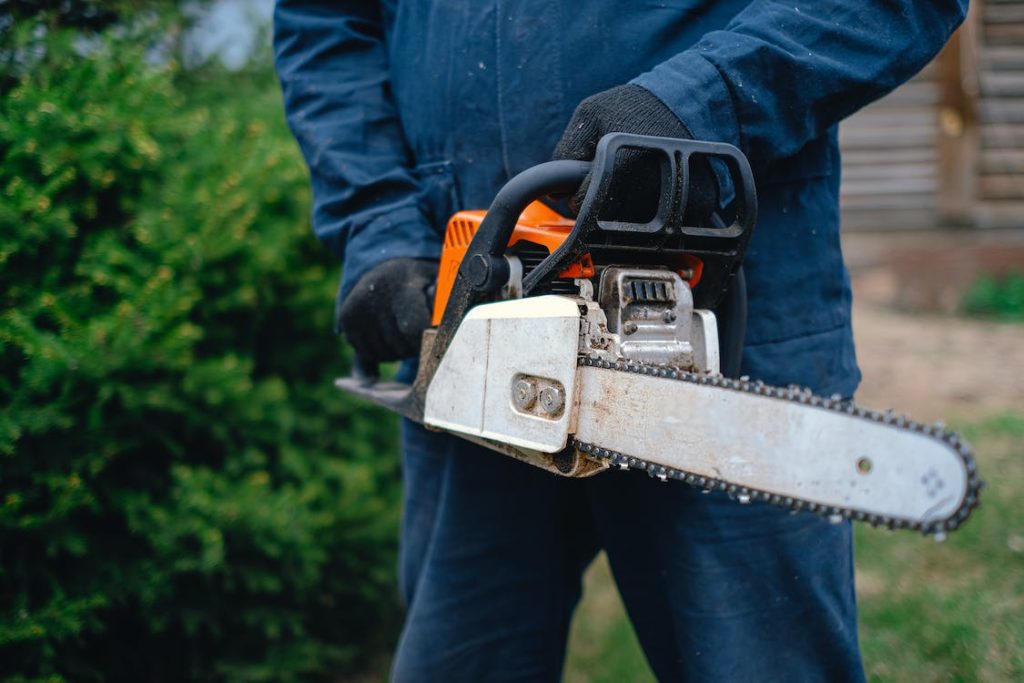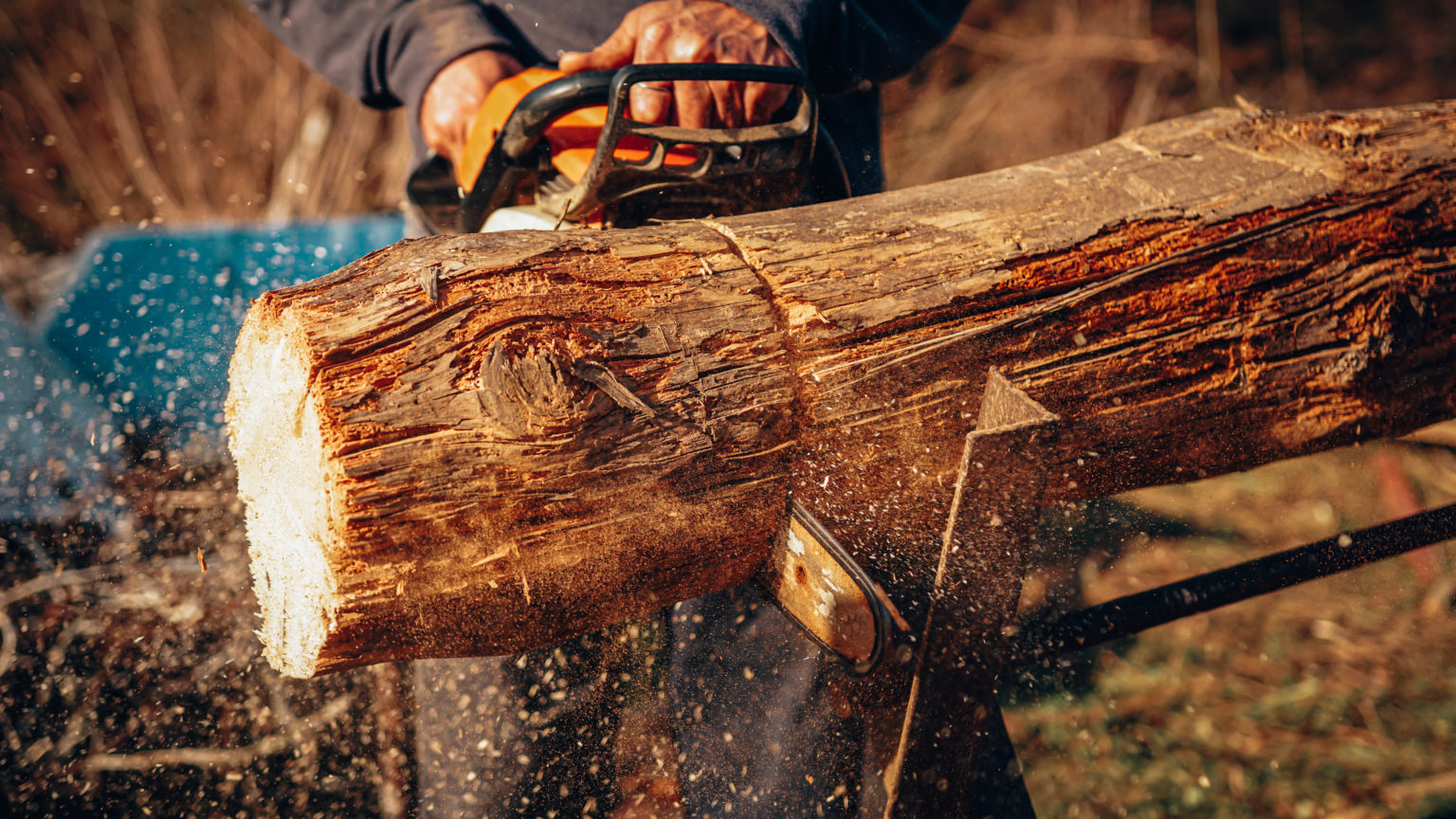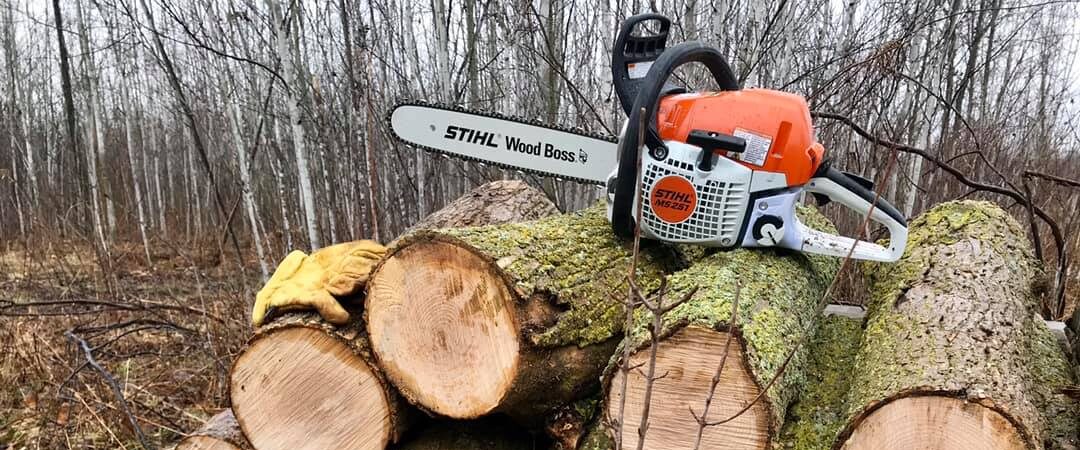A chainsaw can serve you efficiently for at least a decade if you take care of it. However, machinery can fail sometimes, especially if you don’t practice proper maintenance. One common problem with a failing chainsaw is that it cuts crookedly. This article outlines the common causes of chainsaws cutting crooked and explains a few solutions.
How to Determine the Cause of Crooked Cutting
Chainsaw not cutting straight? From poor sharpening to uneven teeth, there are a variety of reasons why this happens. Some causes of chainsaws cutting crooked include:
- Inadequate sharpening
- Damaged saw teeth
- Unequal top plate
- Improper chain tension
- Bent bar
- Incorrect depth gauge
Inadequately Sharpened Chainsaw
Your chainsaw tends to curve to one side when cutting if it’s been sharpened unevenly. The chainsaw may cut more effectively on one side of the teeth than the other, making the blade push more to the side that’s sharpened properly. This tends to happen if you manually sharpen your chainsaw. Since the majority of people favor one hand over the other, it’s normal to sharpen chainsaw teeth more when using the dominant hand.
If you manually sharpen your chainsaw’s teeth, it’s important to make sure you’re doing it evenly. If you’re not sure you can do the job correctly, you can take it to a professional for sharpening.
How to sharpen a chainsaw

To fix a dull or unevenly sharpened chainsaw, you need to pay more attention to the side you sharpen with your non-dominant hand to ensure that both sides match. Pay equal attention to both sides every time you sharpen to achieve a decent edge.
A much better solution is to ditch the manual sharpening method for a chainsaw sharpener. Using a grinder will allow you to set the angle, depth, and length before sharpening so that you achieve even sharpness.
- Durable ➡ The latest, hardest titanium-coated diamond WHEEL we’ve ever made, owns a long lifetime. So you don't have to replace it often, 6 pcs [5/32''×2, 3/16'' ×2, 7/32'' ×2] of wheels are provided which can help sharpen any of the chains out there. Less but better.
- Easy to Use ➡ No chain removal required, No replacement parts needed, Only 4 installation steps are needed at the first time of usage, and an easy-to-follow VIDEO is provided. Let's simplify your sharpening work with this helpful Chain saw Sharpener.
- Fast Result ➡ This is a HIGH-POWER sharpening tool, which means that even sharpen the bluntest chain, you can see how quickly your sharpening work could be done just in a few minutes. And get rid of troublesome hand sharpening once and for all. This is a great replacement for hand chain saw file/ sharpener.
- Accuracy ➡ With the Angle Attachment' help, see how easily you can be a professional and sharpen chainsaw blade at an exact angle & depth, which can efficiently makes the chain razor-sharp & protects the chain from wrong-angle damage. Thus, getting you chain back to razor sharp is no longer a unique ability of hand files.
- Perfect Assistant ➡ This efficient chainsaw sharpener is the perfect companion for chainsaws. It sharpen the chain, protects the chain, makes work easier & safer than ever before. And the exquisite packaging makes it a unique and practical GIFT for father husband and logger. So, get it and you will find you are a cool working style leader!
Damaged Saw Teeth
After heavy use, you can expect your chainsaw’s teeth to become dull, chipped, or damaged. Chainsaw teeth can also get damaged if you hit a nail or rock while cutting.
There’s no way such teeth will bring out smooth cuts on your wood. A chainsaw with damaged teeth will bend or pull in one direction. You might also experience increased vibration, or your chainsaw may catch onto wood and splinter it mid-cut. The result will be crooked cutting.
How to Fix the Teeth
To achieve even cutting, it’s important to make all your chainsaw teeth uniform. If they’re not of equal size, the longer side will always take big bites causing crooked cuts. Counting the number of times you sharpen each tooth is one way to make sure that they’re the same size.
If the teeth are blunt, you can sharpen them using a grinder. You can also help to maintain the teeth by ensuring that your work environment doesn’t contain things that can damage them. Get rid of rocks, nails, and other objects that can be hazardous. If some teeth are missing or a good number are shortened due to wear and tear, you’ll need to replace the chain itself.
- Bench or wall mounted Professional grinder: Perfect for semi-professional and home users who regularly saw wood
- Save time & money: Sharpen your own chainsaw chains. Grinder easily mounts to a bench or wall with two included bolts - ideal for a workshop or garage
- Universal sharpener: Sharpens up to .404” pitch chain. Sharpen almost saw any chain from manufacturers such as Oregon, Stihl, Husqvarna, and others
- One-way motor rotation: Provides greater operator safety and comes with a manual chain clamping vice
- Includes: Grinder, a dressing brick and profile guide, operator instructions plus two grinding wheels (3.2mm & 4.7mm) and a 6.0mm flat profile disc for depth gauge maintenance
Unequal Top Plate
The top plate of a chainsaw is located perpendicular to where the chain spins. It’s the cutting surface located under the top of the cutter. For your chainsaw to cut smoothly, all the plates must be of equal length. If the top plate is not equal, the teeth will take unequal bites. The chainsaw will curve to the side that’s taking the bigger bites, resulting in crooked cuts.
How to Fix the Plates
You need to ensure all the top plates are equal by sharpening them. Make sure you sharpen the longer plates until you reduce them to the same length as the shorter ones. The angles should also match so that it doesn’t cause other issues.
Improper Chain Tension
If you’re not familiar with how to use a chainsaw, you might not realize that it needs to have the proper chain tension to work optimally. Sometimes, the chain may become loose, causing uneven cutting. Not only that, the chain can pull off and injure you in the process.
You’ll also experience problems with your chainsaw if the chain is too tight. In that case, the teeth won’t be able to move freely, giving you crooked cuts. This can also cause overheating, which is a fire hazard.
How to Adjust the Tension
If your chain is too tight, loosen it; and if it’s too loose, tighten it. Make sure you tighten the nuts well after doing this, so they don’t come loose and cause problems.
Bent Bar
The bar is one of the strongest components of a chainsaw, but it can wear out over time due to friction. A bent bar is one of the signs your chainsaw is worn out. If this is not addressed, it will start cutting crooked. The bend doesn’t only interfere with efficiency, either; using your chainsaw with such a problem can also be dangerous.
How to Fix the Bar
It’s not always easy to figure out if your bar is bent. The best way is to remove it from the chainsaw altogether and check the grooves from both sides. If you find a bend, it’s time to fix it. Minor bends can easily be fixed by hitting the sides with a rubber mallet, but more drastic bends probably mean you’ll have to replace the bar.
Incorrect Depth Gauge
A depth gauge is what provides a flat surface across your chainsaw’s teeth. They are those small protrusions you notice on the front of your chainsaw’s teeth. The depth gauge controls how deep the cutter teeth penetrate. According to manufacturers, the proper depth should be 1/4 inch. If the teeth of your chainsaw blade are uneven, they will not cut properly. The top plate of the cutter tooth angles back slightly, so you need to lower the depth gauge as you file the cutter teeth back.
How to Fix the Gauge
Before you start using your chainsaw, check to confirm that the depth gauge is in its correct setting. If the setting is incorrect, use a depth gauge and file guide tools to measure the gauges. Place the tool on the top of the chain lying flat so that the gauge can slide upward on the tool’s slot. Make sure the depth gauge is on the same level as the tool’s slot. File it down if it’s too tall. Do the same for all the teeth until they’re all level.
Other Common Chainsaw Problems

There are a variety of other chainsaw problems that can impact how well the tool works. Some can contribute to crooked cutting, while others can cause issues as you work. You can often fix minor problems and then get back to work, though other problems may require the intervention of a professional. Here are some common chainsaw problems:
Overheating
Your chainsaw can overheat from time to time, especially during the summer months. If ignored, these problems can damage your chainsaw or, worse, cause a fire hazard, putting you at risk. To combat this problem, you need to clean your chainsaw to get rid of wood particles and sawdust that may get stuck inside the exhaust. Make sure you clean your chainsaw after every use.
Failing to Start
Sometimes your chainsaw can fail to start just when you’re set to start cutting. One of the causes of this problem can be a defective spark plug. The spark plug may have cracked porcelain, a damaged electrode, or heavy carbon buildup. If any of these happens, you’ll need to replace the spark plug.
Another problem can be a clogged carburetor. Leaving fuel in your chainsaw too long will clog the carburetor and prevent the engine from starting. If you’re not using the chainsaw, make sure you drain out the fuel.
Chainsaw Stalls
At times, the chainsaw may start and then stall. This can happen if the spark arrestor fails to emit sparks. The most common reason for this is soot clogging the arrestor after staying for a long time without being used. Remove and clean the spark arrestor.
A clogged air filter can be another cause of stalling. Clogged air filters result in the engine receiving too much fuel without any air to actually let it use the fuel. Clean or replace the air filter to resolve this.
Chainsaw Won’t Cut
Forget about the chainsaw cutting crooked — sometimes, it won’t cut at all. The main cause for this can be a dull chainsaw, which you can solve by simply sharpening the tool. The chainsaw can also fail to cut because the chain is too tight or too loose. If the problem is with the guide bar, you need to replace it instead of repairing it.
Chainsaw Maintenance Tips
Like any other tool, a chainsaw can encounter problems. Some of these problems may be because your old chainsaw needs replacement. Others can be due to improper usage. Maintaining your chainsaw can help avoid some problems. Here are tips for doing it:
Clean Your Chainsaw
Dust and debris get stuck in a chainsaw whenever you use it. Over time, this debris, which can include sawdust and tree particles, can clog the parts of your chainsaw, interfering with its efficiency. Make sure to clean carefully, as the process differs for every part. When reassembling the chainsaw after cleaning it, make sure everything is seated properly to avoid potential issues.
Keep the Blades Sharp
Dull blades are a common chainsaw problem. Dull blades tend to cut crooked and may discharge sawdust instead of saw chips. Blunt blades are a safety hazard because they can cause the saw to jump when cutting.
Replace the Gas
If you store your chainsaw too long with gasoline inside it, you will have problems the next time you use it. Don’t leave gas inside your chainsaw for more than 30 days. If you did this, then replace the gas before using your chainsaw again. Another alternative is to use a fuel stabilizer to keep the gas inside your chainsaw fresh for several months.
How to Clean Out a Chainsaw Gas Tank
Lubricate the Chainsaw
Lubricating your chainsaw will prevent the guide bar and the chain from rubbing against each other and causing friction. However, be careful not to lubricate with too much oil, as this will cause debris to stick to it.
- ECO-FRIENDLY LUBRICANT: With ultimate biodegradability, our green, non toxic chainsaw oil is made from North American grown plant oils, so it’s safer for you, safer for your pets and safer for the environment than petroleum based products.
- HIGH PERFORMANCE: Our professional Pro100 Bar & Chain Oil has a high flash point up to 600°F and excellent temperature stability even in extreme conditions. The all season bio-based commercial quality lubricant has a minus 20°F pour point.
- PROFESSIONAL QUALITY: Safer for your employees and better for your equipment, our yard-safe supreme grade chainsaw oil offers outstanding lubricity, superior wear protection, and is high tack to reduce high speed oil sling.
- NON TOXIC FORMULA: Containing no petroleum base oils or metal-based additives, our eco-friendly lubricant is ideal for chainsaws as they are 100% loss applications. This green lube is suitable for use around waterways and other sensitive areas.
- MADE IN THE USA DEWALT Bar & Chain Oil is USDA Certified Bio-based Product
Final Thoughts
Your chainsaw can serve you for 10-20 years without any problems, but this can only happen if you maintain it well. Make sure to sharpen it, clean the filters, and lubricate the chains periodically. Don’t leave fuel inside it for a long time. Don’t hit rocks or nails when cutting, and don’t use it in damp conditions.
If you’ve looked at these possible causes and still can’t figure out the problem causing your chainsaw not to work properly, it’s best to seek help from a professional with experience in chainsaw repair. They’ll be able to diagnose the issue and repair your saw. If they can’t, they’ll let you know that it’s time to replace your chainsaw altogether.




